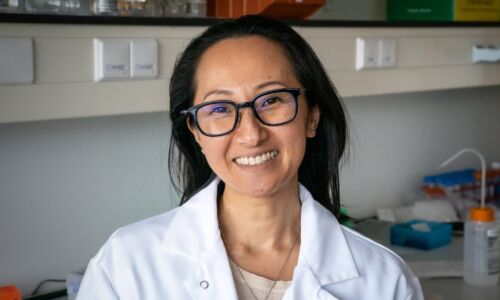Can we tweak cells to reset their ageing clock?
-
 Okinawa, a city in Japan, is known as a Blue Zone: a region where people live significantly longer and healthier lives. Photo: rabbit_akra / Flickr
Okinawa, a city in Japan, is known as a Blue Zone: a region where people live significantly longer and healthier lives. Photo: rabbit_akra / Flickr
Ageing is the main risk factor for the vast majority of diseases - yet we know surprisingly little about why it makes us so vulnerable. Researchers at the Radboud Institute for Molecular Life Sciences are looking for answers at a cellular and molecular scale. ‘Ageing is not necessarily a one-way street, but it’s instead kind of malleable.’
Among the most intriguing phenomena in human ageing are supercentenarians—individuals who not only surpass the age of 110, but often do so in remarkably good health. ‘Why these people live like this is one of the big secrets that everyone is trying to find out,’ says Peter Tessarz, chair of the Human Biology department. His lab looks at ageing through a microscopic lens. It all comes down to how ageing affects the smallest unit of life, the cell. And zooming in even further, the DNA.
When scientists interested in longevity drew circles on a map with a blue pen, they probably didn’t think that this would open up the way for a multimillion business, thousands of articles, and a Netflix series. These areas came to be known as ‘blue zones’ and there are about five places in the world with this title, such as Okinawa (Japan) and Sardinia (Italy), where most people seem to live exceptionally long.
DNA changes
There is still some skepticism about whether these places actually exist. ‘It could be a statistical issue rather than actual blue zones since these regions are usually secluded and often have very poor records of birth certificates,’ explains Tessarz. Regardless of whether these blue zones hold the answers for longevity or not, the huge media coverage they received surfaces an interesting issue – how preoccupied, and perhaps afraid, we are of ageing. It affects us all.
‘What the field goes back to all the time is that ageing is not necessarily a one-way street, but it’s instead kind of malleable,’ says Tessarz. This became especially apparent when, a few years back, scientists made a breakthrough discovery and managed to rejuvenate cells. When cells age, the way they read their DNA changes, parts of the genetic material become more or less accessible. Researchers found that if they use four specific proteins, called the Yamanaka transcription factors, which bind sections of the DNA and as a result some genes are turned on or off, cells can be brought back to a stage where they resemble young cells.
This is called cellular reprogramming and scientists have been using the principle of this technique to make induced pluripotent stem cells for almost two decades. During development, the youngest cells in our body start as undifferentiated cells or stem cells, which can become any type of cell, from neurons to skin cells – hence the term ‘pluripotent’.
Coincidence
However, when it comes to rejuvenating cells, ‘you don’t want to completely change cellular identity,’ says Tessarz. This is dangerous in an organism because a stem cell induced from, for instance, a pancreatic cell, could turn into a liver cell or any other cell type – this way cancer can arise.
So, instead of fully reprogramming cells all the way back to pluripotent stem cells, researchers realized that they can use the Yamanaka factors for shorter periods to partially reprogram the cells in mice. They bring the cells into an intermediate state from where they return to their original identity, but in doing so, the cellular clock is set back. Essentially, the cells remember what type they need to be, but they get a fresh start.
‘This is truly an epigenetic effect,’ points out Tessarz. Epigenetic (epi-above; genome-all genetic information) refers to changes in the way the DNA is expressed or read, but without alterations in the DNA itself. ‘It was just a very lucky coincidence that when I started my lab, this paper came out and epigenetics in ageing kind of became a thing.’
His research focuses on how the metabolism impacts the epigenome and thereby regulates how genes are expressed or turned off in the context of ageing. ‘Metabolism changes quite dramatically when we age. Actually, one of the few ways that we know nowadays work well when we want to live longer and healthier, is to place a lot of emphasis on how we eat and what we eat,’ explains Tessarz. Many of the diseases that we die of have ageing as the main risk factor – if you can tackle ageing, you likely also directly tackle all these diseases. ‘Virtually every process at a cellular level is impacted somehow by ageing. The question now is whether it is the driver, or it is just sitting somewhere in that car. Epigenetics has a good chance of being one of the drivers here, as does metabolism.’
Long-term goal
Tessarz and his lab are really interested in how these processes are affected by the surroundings of cells. Tissues are not homogeneous lumps of cells. ‘Within a tissue there are microenvironments, which can be high or low in oxygen, in certain hormones and so on, depending on their location. What we are trying to understand is how changes with age in these tissue environments impact the metabolism-epigenetics crosstalk and the rejuvenation attempts we are trying to establish.’
‘The recent increase in lifespan often comes with a much longer time of suffering’
This complexity is not easy to tackle – ‘this will keep me busy until the end of my career,’ confesses the researcher with a smile – but they have promising discoveries. ‘If you understand how this crosstalk works, it’s fairly easy to interfere in metabolic pathways, either by changing diet or with drugs – and we’ve shown this’. In a type of stem cells, Tessarz’ lab identified what was going wrong in the metabolism due to ageing and managed to rescue the defect, essentially rejuvenating the cells. ‘But this is in a dish. A long-term goal would be to use similar strategies to positively impact, for instance, health span and cancer therapy, because dysregulated metabolism plays a huge role in tumor development,’ says Tessarz. According to the researcher, there are developments in many different fields that people who are now growing old will strongly benefit from.
In the end, perhaps the secret of the supercentenarians is not so much about finding the fountain of youth, but rather an improved quality of life. ‘The recent increase in lifespan often comes with a much longer time of suffering, people lay in bed, they have to be cared for. What we would really like to do as a field is to shorten this time when people suffer and increase the time when they can live their life in a healthy state.’


